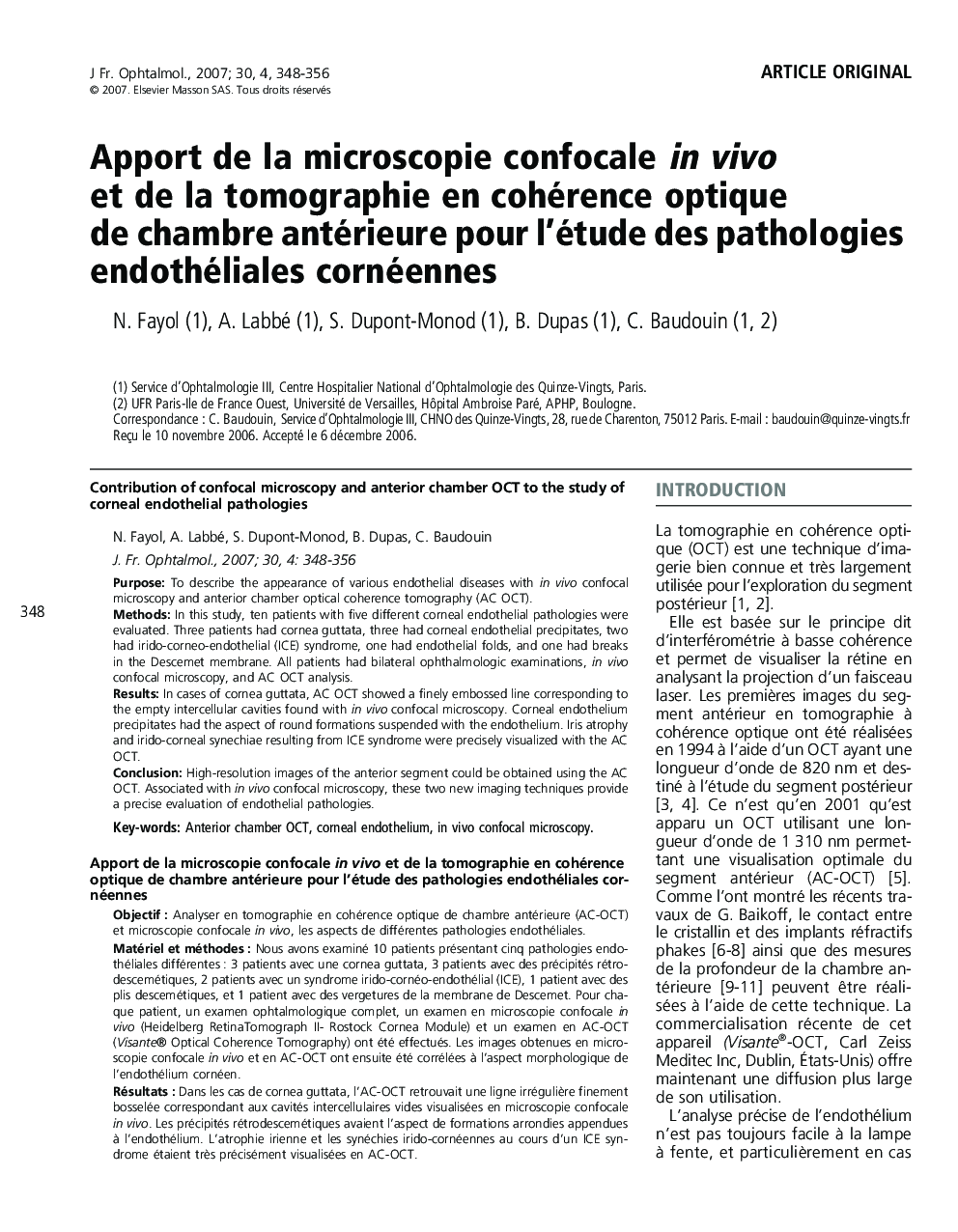| کد مقاله | کد نشریه | سال انتشار | مقاله انگلیسی | نسخه تمام متن |
|---|---|---|---|---|
| 4025282 | 1262350 | 2007 | 9 صفحه PDF | دانلود رایگان |

ObjectifAnalyser en tomographie en cohérence optique de chambre antérieure (AC-OCT) et microscopie confocale in vivo, les aspects de différentes pathologies endothéliales.Matériel et méthodesNous avons examiné 10 patients présentant cinq pathologies endothéliales différentes : 3 patients avec une cornea guttata, 3 patients avec des précipités rétrodescemétiques, 2 patients avec un syndrome irido-cornéo-endothélial (ICE), 1 patient avec des plis descemétiques, et 1 patient avec des vergetures de la membrane de Descemet. Pour chaque patient, un examen ophtalmologique complet, un examen en microscopie confocale in vivo (Heidelberg RetinaTomograph II- Rostock Cornea Module) et un examen en AC-OCT (Visante® Optical Coherence Tomography) ont été effectués. Les images obtenues en microscopie confocale in vivo et en AC-OCT ont ensuite été corrélées à l'aspect morphologique de l'endothélium cornéen.RésultatsDans les cas de cornea guttata, l'AC-OCT retrouvait une ligne irrégulière finement bosselée correspondant aux cavités intercellulaires vides visualisées en microscopie confocale in vivo. Les précipités rétrodescemétiques avaient l'aspect de formations arrondies appendues à l'endothélium. L'atrophie irienne et les synéchies irido-cornéennes au cours d'un ICE syndrome étaient très précisément visualisées en AC-OCT.ConclusionL'AC-OCT permet d'obtenir des images de haute résolution du segment antérieur. Associée à la microscopie confocale in vivo, il est possible d'analyser la cornée dans deux plans de l'espace, permettant ainsi une meilleure documentation iconographique et une meilleure approche des pathologies endothéliales.
PurposeTo describe the appearance of various endothelial diseases with in vivo confocal microscopy and anterior chamber optical coherence tomography (AC OCT).MethodsIn this study, ten patients with five different corneal endothelial pathologies were evaluated. Three patients had cornea guttata, three had corneal endothelial precipitates, two had irido-corneo-endothelial (ICE) syndrome, one had endothelial folds, and one had breaks in the Descemet membrane. All patients had bilateral ophthalmologic examinations, in vivo confocal microscopy, and AC OCT analysis.ResultsIn cases of cornea guttata, AC OCT showed a finely embossed line corresponding to the empty intercellular cavities found with in vivo confocal microscopy. Corneal endothelium precipitates had the aspect of round formations suspended with the endothelium. Iris atrophy and irido-corneal synechiae resulting from ICE syndrome were precisely visualized with the AC OCT.ConclusionHigh-resolution images of the anterior segment could be obtained using the AC OCT. Associated with in vivo confocal microscopy, these two new imaging techniques provide a precise evaluation of endothelial pathologies.
Journal: Journal Français d'Ophtalmologie - Volume 30, Issue 4, April 2007, Pages 348-356